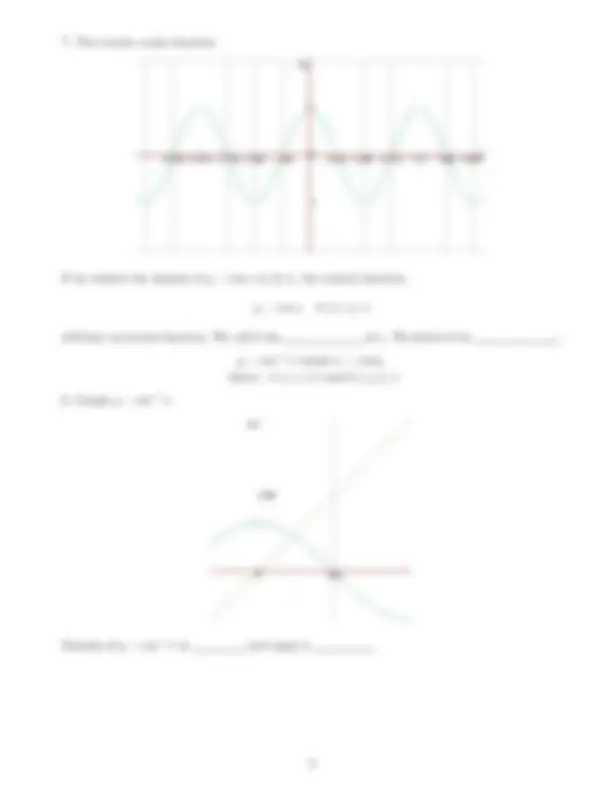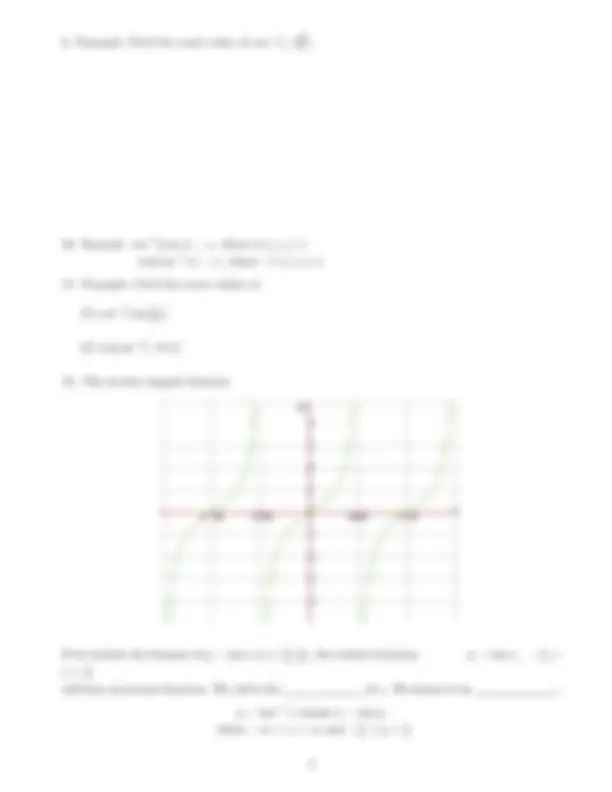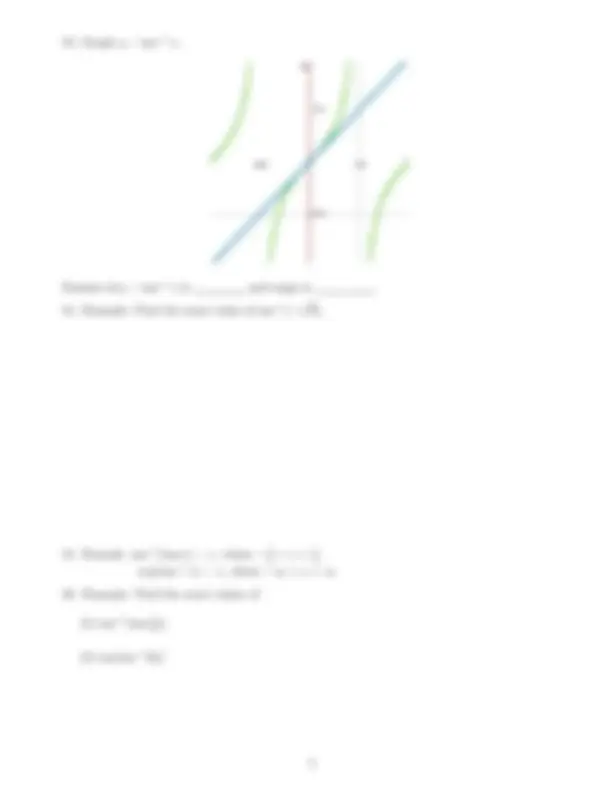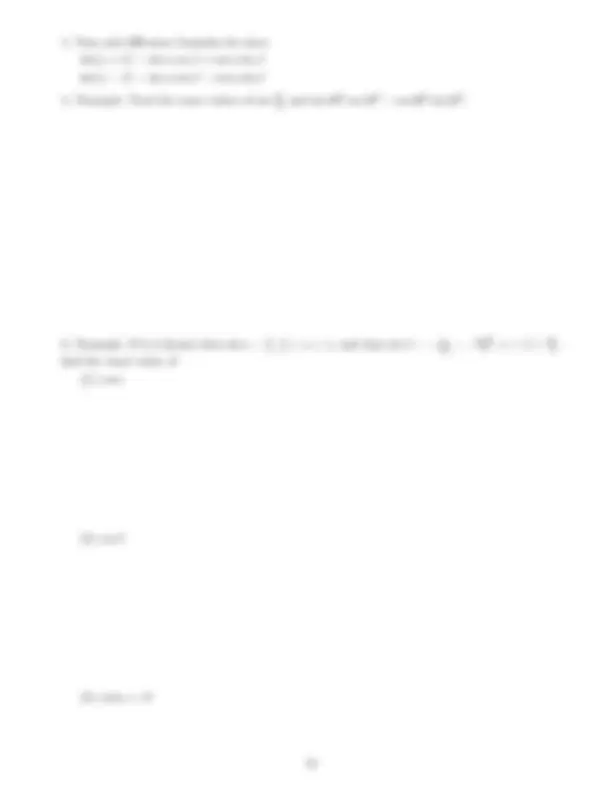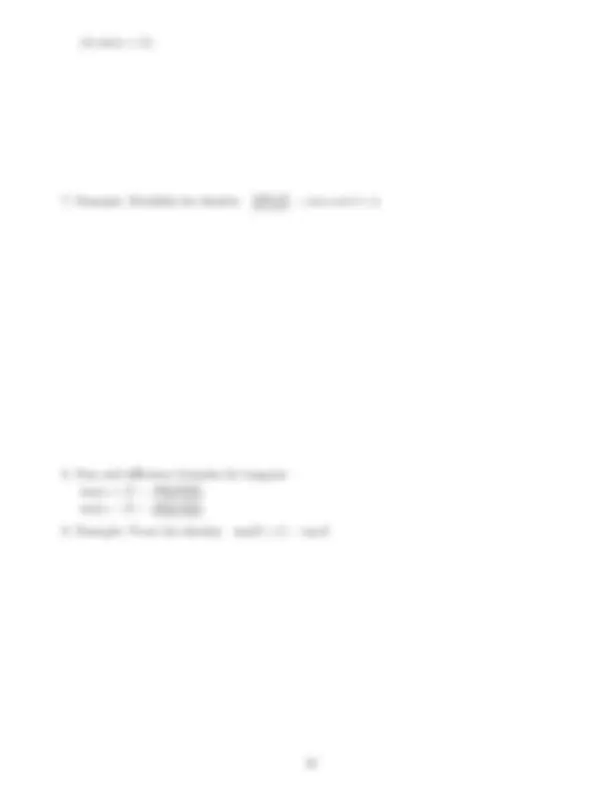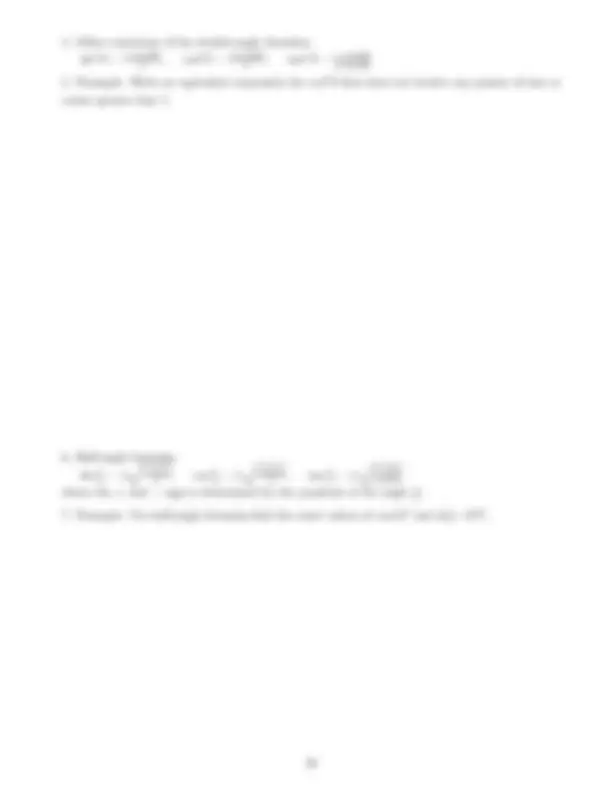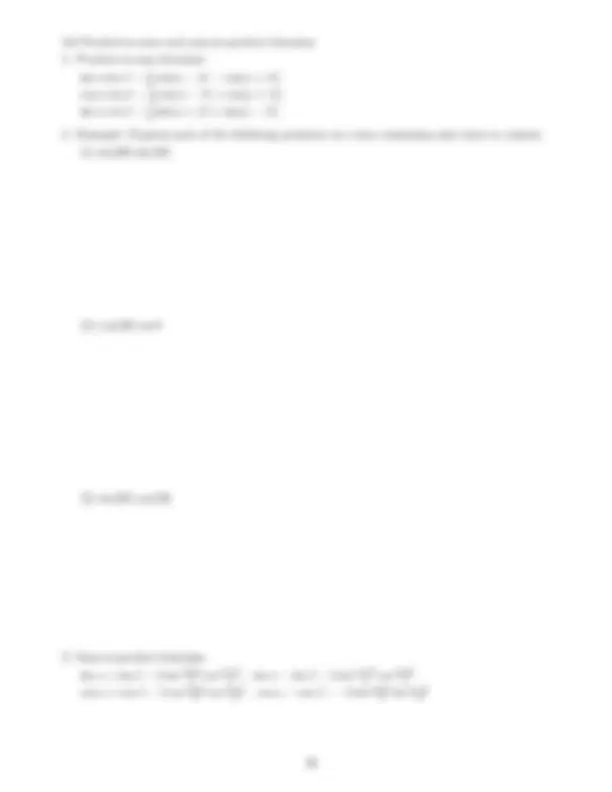Download Analytic Trigonometry - Lecture Notes | MATH 124 and more Study notes Trigonometry in PDF only on Docsity!
Chapter 3. Analytic Trigonometry 3.1 The inverse sine, cosine, and tangent functions
- Review: Inverse function (1) f −^1 (f (x)) = x for every x in the domain of f and f (f −^1 (x)) = x for every x in the domain of f −^1. (2) Domain of f = range of f −^1 , and range of f = domain of f −^1. (3) The graph of f and the graph of f −^1 are symmetric with respect to the line y = x. (4) If a function y = f (x) has an inverse function, the equation of the inverse function is x = f (y). The solution of this equation is y = f −^1 (x).
- The inverse sine function
If we restrict the domain of y = sin x to [−π 2 , π 2 ], the restrict function
y = sin x, −π 2 ≤ x ≤ π 2
will have an inverse function. We call it the of x. We denote it by :
y = sin−^1 x means x = sin y, where − 1 ≤ x ≤ 1 and −π 2 ≤ y ≤ π 2
- Graph y = sin−^1 x.
Domain of y = sin−^1 x is and range is.
- Example: Find the exact value of sin−^1 (−^12 ).
- Remark: sin−^1 (sin x) = x, where −π 2 ≤ x ≤ π 2 sin(sin−^1 x) = x, where − 1 ≤ x ≤ 1
- Example: Find the exact value of (1) sin−^1 [sin(π 8 )]
(2) sin[sin−^1 (−
√ 3 2 )]
- Example: Find the exact value of cos−^1 (−
√ 2 2 ).
- Remark: cos−^1 (cos x) = x, where 0 ≤ x ≤ π cos(cos−^1 x) = x, where − 1 ≤ x ≤ 1
- Example: Find the exact values of
(1) cos−^1 [cos( 12 π )]
(2) cos[cos−^1 (− 0 .4)]
- The inverse tangent function
If we restrict the domain of y = tan x to (−π 2 , π 2 ), the restrict function y = tan x, −π 2 < x < π 2 will have an inverse function. We call it the of x. We denote it by :
y = tan−^1 x means x = tan y, where −∞ < x < ∞ and −π 2 < y < π 2
- Graph y = tan−^1 x.
Domain of y = tan−^1 x is and range is.
- Example: Find the exact value of tan−^1 (−
- Remark: tan−^1 (tan x) = x, where −π 2 < x < π 2 tan(tan−^1 x) = x, where −∞ < x < ∞
- Example: Find the exact values of
(1) tan−^1 [tan(π 8 )]
(2) tan[tan−^1 (6)]
- Example: Find the exact value of cos[sin−^1 (−^13 )].
- Example: Find the exact value of tan[cos−^1 (−^13 )].
- The remaining inverse trigonometric functions: y = sec−^1 x means x = sec y, where |x| ≥ 1 and 0 ≤ y ≤ π, y 6 = π 2. y = csc−^1 x means x = csc y, where |x| ≥ 1 and −π 2 ≤ y ≤ π 2 , y 6 = 0. y = cot−^1 x means x = cot y, where −∞ < x < ∞ and 0 < y < π.
- Example: Find the exact value of csc−^1 2.
- Example: Establish the following identities: (1) csc θ · tan θ = sec θ
(2)sin^2 (−θ) + cos^2 (−θ) = 1
(3) sinsin(^2 (−−θθ))−−coscos(^2 −(−θθ) )= cos θ − sin θ
(4) 1+tan 1+cot θθ = tan θ
(5) (^) 1+cossin^ θ θ + 1+cos sin θ^ θ= 2 csc θ
(6) tan sec^ θ θ+cot csc θ^ θ = 1
(7) 1 − cossin θ^ θ= (^) 1+sincos^ θ θ
3.4 Sum and difference formulas
- Sum and difference formulas for cosines cos(α + β) = cos α cos β − sin α sin β cos(α − β) = cos α cos β + sin α sin β
- Example: Find the exact values of cos 75^0 and cos 12 π.
- cos(π 2 − θ) = sin θ sin(π 2 − θ) = cos θ
- Sum and difference formulas for sines sin(α + β) = sin α cos β + cos α sin β sin(α − β) = sin α cos β − cos α sin β
- Example: Find the exact values of sin 712 π and sin 80^0 cos 20^0 − cos 80^0 sin 20^0.
- Example: If it is known that sin α = 45 , π 2 < α < π, and that sin β = − √^25 = −^2
√ 5 5 ,^ π < β <^
3 π 2 , find the exact value of (1) cos α
(2) cos β
(3) cos(α + β)
- Example: Prove the identity tan(θ + π 2 ) = − cot θ.
- Example: Find the exact value of sin(cos−1 1 2 + sin−1 3 5 ).
- Example: Write sin(sin−^1 u + cos−^1 v) as an algebraic expression containing u and v (that is, without any trigonometric functions).
3.5 Double-angle and half-angle formulas
- Double-angle formulas sin(2θ) = 2 sin θ cos θ cos(2θ) = cos^2 θ − sin^2 θ cos(2θ) = 1 − 2 sin^2 θ cos(2θ) = 2 cos^2 θ − 1
- Example: If sin θ = 35 , π 2 < θ < π, find the exact values of sin(2θ) and cos(2θ).
- Example: (1) Develop a formula for tan(2θ) in terms of tan θ.
(2) Develop a formula for sin(3θ) in terms of sin θ and cos θ.
- Example: If cos α = −^35 , π < α < 32 π , find the exact value of (1) sin α 2
(2) cos α 2
(3) tan α 2.
- Half-angle for tan α 2 tan α 2 = 1 − sincos α^ α= (^) 1+cossin^ α α.
3.6 Product-to-sum and sum-to-product formulas
- Product-to-sum formulas sin α sin β = 12 [cos(α − β) − cos(α + β)] cos α cos β = 12 [cos(α − β) + cos(α + β)] sin α cos β = 12 [sin(α + β) + sin(α − β)]
- Example: Express each of the following products as a sum containing only sines or cosines: (1) sin(6θ) sin(4θ)
(2) cos(3θ) cos θ
(3) sin(3θ) cos(5θ)
- Sum-to-product formulas sin α + sin β = 2 sin α+ 2 βcos α− 2 β, sin α − sin β = 2 sin α− 2 βcos α+ 2 β cos α + cos β = 2 cos α+ 2 βcos α− 2 β, cos α − cos β = −2 sin α+ 2 βsin α− 2 β

